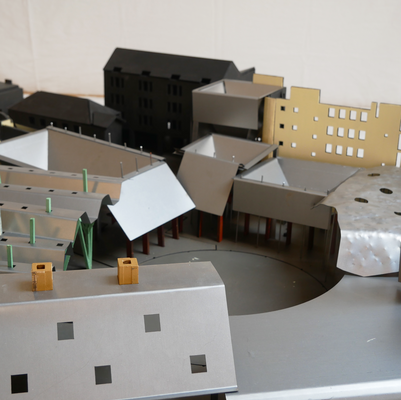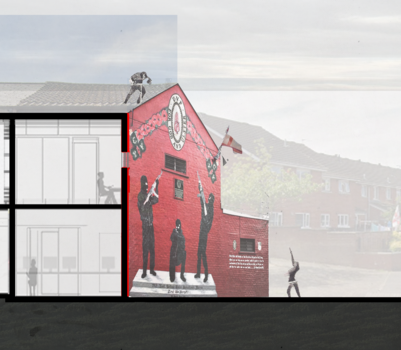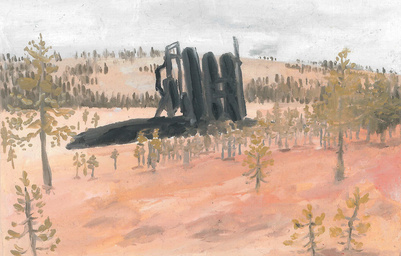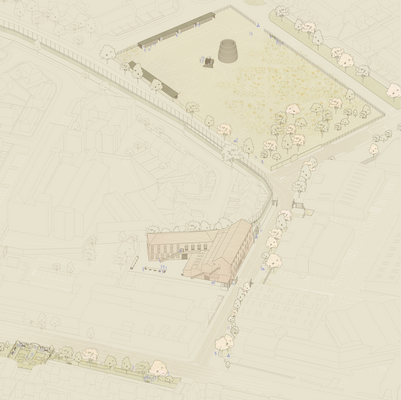With feminist and intersectional tools, I aim to destabilise the colonial, patriarchal and supremacist mindset within the architecture discipline that are still invisible in the practice of architecture. By providing youth from socially challenged neighbourhoods around Copenhagen a free preparatory course for the entrance examinations to architecture schools, I enter the discourse about diversity in our profession.
One of the tools I’ve learnt from feminist architecture theorists is the use of citations, a form of intellectual collaboration, making the voices of minorities and of stories outside of the canon louder. A collective assemblage of enunciation, which is also one of the strategies of the minor architect. This project is also a collage of different voices curated together to create a new world.
"[...] what artists do is make a particularly skillful selection of fragments of cosmos, unusually useful and entertaining bits chosen and arranged to give an illusion of coherence and duration amidst the uncontrollable streaming of events. An artist makes the world her world. An artist makes her world the world. For a little while. For as long as it takes to look at or listen to or watch or read the work of art. Like a crystal, the work of art seems to contain the whole, and to imply eternity. And yet all it is is an explorer’s sketch-map. A chart of shorelines on a foggy coast." (Ursula K. Le Guin: World-Making)
In 2020, a series of events started unfolding globally and within Denmark that challenges our western, colonial and patriarchal mindset and culture. Black Lives Matter movements following George Floyd’s murder sparked outrage and protests around the world within minority and indigenous communities. Closer to home, in August 2020 a group of students wrote an open letter to Lene Dammand Lund in light of these events asking about the school’s role in ensuring diversity and equality which she addressed in the 20/21 academic year opening film. On another strand, following a new wave of #MeToo movement in Denmark, Sexism in Architecture, which today is called Building Diversity started collecting evidence for sexual harassment in the architecture field.
These movements have started strong, and with their momentum they started an avalanche towards a cultural shift in our profession. Activists through their work challenge deep-rooted systemic inequalities, and represent groups that are otherwise excluded. They create safe spaces, not spaces, where everyone agrees, but rather spaces where people know and can learn how to cope in situations of risk. And it is this space, where I would like to contribute with my project—to this collective assemblage of enunciation.
To challenge systemic inequalities, a good feminist would ask the following questions:
- Who is in the room?
- Who is invited to practice architecture?
- Where does an architect come from?
- And how far out in the world are we reaching with our expertise?
"The third is the subject myth in the person of the gatekeeper, whose horrifying face is potentially rendered almost amiable by the specter of an even more horrible gatekeeper that looms beyond the next gate, and so on, and on. But the supplicant cannot disbelieve the gatekeeper’s powerful presence; he is paralyzed by the perceived authority, as though the gatekeeper himself were the architect of the law/object and sovereign over its interior." (Jill Stoner, Toward a Minor Architecture)
There is a mysterious storage unit in the event space of the Association. It holds drawing and model making tools, papers, cutting boards, glue, pencils, charcoal, ink, brushes, scissors, and alike.

It is a Saturday in the not so distant future at the Association of Architects. The event space is filled with young people from socially and economically vulnerable areas around Copenhagen. They are taking a tuition-free preparatory course for the entrance examination at the Royal Danish Academy, School of Architecture.
One of the students accidentally spills ink on the wooden floor. The ink soaks deep into the floor, leaving a mark of the course for the Association to see it on the following Monday.
"To object (v) to the object (n). To register objections is to draw lines through objects of power, objects that are the result of institutions, which in turn rely on knowledge. Knowledge itself is a massive heavy object, with enormous foundations and a reliance on gravity. Theories and philosophies are constructed on the backs of canonical precedents. Like doctrines, they are dangerously authoritarian. Religions, monarchies, systems of law, corporations—these historical patrons of architecture have provided us with the objects upon which minor architects can write (or draw) their objections.
The english word draw comes from the root *dhragh, which it shares with the word draft, meaning “to pull.” Draft beer is pulled from the tap, the draft horse pulls the wagon, the draftsman pulls the pencil across the page. We draw people out in conversation, we draw conclusions from evidence. A line of force has the same pull as the pull of the draft, the draw, the art of drafting, which is also the disegno, the design. The act of drawing a line through an object is politicized by the force of the draw. This gives a building new agency.”" (Jill Stoner, Toward a Minor Architecture)
With this course, I’m creating a space that resonates with Édouard Glissant’s theory, For Opacity. The students’ identity, ethnicity, their addresses are invisible to the people working at the Association. They are not sharing the building at the same time. The institution not only knows about, but supports the preparatory course. But they don’t see the students. I’m minimising the chance for discrimination.
I’m also creating a space that allows for our automatic benevolent subjectivity to continue to exist with which the profession often identifies with: to do something good for people who are less privileged. While also allowing space for a slower shift in our perception about discrimination from a personal moral trait towards a societal and cultural context, so we can start taking responsibility about it and make changes collectively.

This is now the third year of the free prep course. Students, who went to the first year of the course, and gotten accepted at the academy are now back as teachers every Saturday to share their newly acquired knowledge. The now academy students take pride in teaching what they just learnt, and their experiences from the entrance examination are still fresh, so they can contribute to the course with hands-on knowledge. Their confidence and sense of belonging to the architecture field grows as they help build a community and network of diverse architecture students.
"Opportunities for minor architectures emerge when the soul of a society is understood as more than a singularity, when—though a major soul constructs—minor souls await opportunities to de(con)struct. Minor architectures are, in fact, opportunistic events in response to latent but powerful desires to undo structures of power; and as such, minor architectures are precisely (if perversely) concerned with the privilege and circumstances of major architecture, the architecture of State and economic authority.” (Jill Stoner, Toward a Minor Architecture)

"Difference must be not merely tolerated, but seen as a fund of necessary polarities between which our creativity can spark like a dialectic. Only then does the necessity for interdependence become unthreatening. Only within that interdependency of different strengths, acknowledged and equal, can the power to seek new ways of being in the world generate, as well as the courage and sustenance to act where there are no charters." (Audre Lorde, The Master’s Tools Will Never Dismantle the Master’s House)
It is a sunny weekend in a May after the entrance examination is over. Two semesters of the course is behind us, and we are gathered to celebrate the work that went into giving people—who otherwise wouldn’t have this opportunity—competitive skills to enter the school of architecture.
The student-as-teacher model challenges the relationship between authority and responsibility. A strong community is forming, one in which difference and equality are celebrated. They set up an exhibition of the work they have done throughout the course. We invite the people who work at the Association to celebrate with us, to see the work the students have done, and to meet for the first time.

The students at the course will draw the designer furniture and objects found at the Association, and the fine details of the interior and exterior spaces of the building. Taste is not neutral. Taste is a social hierarchy and privilige. Students will be introduced to traditional Danish aesthetic values and canon which will give them knowledge and thus power to participate in the discipline.
"A minor architect is a minor destructive character, a tinkerer and hacker, journalist and editor, alter ego and subaltern. But tinkerers may sabotage as well as fix, and willfully take apart rather than assemble. Hackers may scramble code as often as decipher it, and editors (to save us from our wordiness) ruthlessly slice the excess away. Were he to tend toward a minor architecture, Valéry’s Eupalinos might choose to say: “By dint of deconstructing, I truly believe that I have deconstructed myself.”” (Jill Stoner, Toward a Minor Architecture)
I’ve learnt from feminist architecture theorists that there is also a softer way to undoing structures of power. You can disguise a movement in a way that is invisible to the dominant voice.







